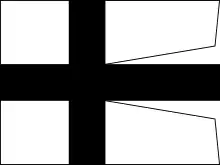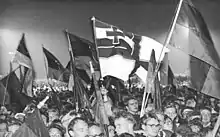Reichskriegsflagge
The term Reichskriegsflagge (German: [ˈʁaɪçsˌkʁiːksflaɡə], lit. 'National War Flag') refers to several war flags and war ensigns used by the German armed forces in history. A total of eight different designs were used in 1848–1849 and between 1867–1871 and 1945.

Today the term refers usually to the flag from 1867–1871 to 1918, the war flag of Imperial Germany.
History
North German Confederation


After Prussia defeated Austria in 1866, the North German Confederation was founded by Prussia in order to replace the former German Confederation in which Austria had been the dominant power. The new Confederation eventually became the German Empire after the Franco-Prussian War, hence the Imperial German flags date back to the North German Confederation.
Because Prussia had emerged as the leading German state and the black-red-golden colour scheme was, at that time, associated with pan-Germanism (a Germany including Austria) and the revolution of 1848, the Prussian King and President of the North German Confederation, Wilhelm I, insisted on using new flags inspired by Prussia and without the traditional German colours. Therefore, the North German and eventually Imperial German flags prominently featured the Prussian colours (black and white) as well as symbols like the Prussian eagle and the Iron Cross. And while seafaring was the traditional domain of the Hanse in Germany, virtually all of the 19th century German coastline (including the North Sea coast) and naval power belonged to Prussia after the decisive victory in 1866.
Prince Adalbert of Prussia, the commander-in-chief of the North German Navy, was commissioned with the task of designing the new war ensign. Around 1850, he already had designed a number of potential war ensigns for a hypothetical German nation-state under Prussian rule, which never were adopted as the project was not realised at that time. He used his old ideas to design the new North German war ensign with heavy involvement of the Prussian King, leading to numerous changes, like the inclusion of the Iron Cross in its original shape.[1]
The flag that was finally adopted became the war ensign of the German Empire after its founding, similar to the North German merchant ensign.
 One of Prince Adalbert's early proposals for a German war ensign.
One of Prince Adalbert's early proposals for a German war ensign. One of Prince Adalbert's early proposals for a German war ensign.
One of Prince Adalbert's early proposals for a German war ensign. One of Prince Adalbert's early proposals for a German war ensign.
One of Prince Adalbert's early proposals for a German war ensign. One of Prince Adalbert's early proposals for a German war ensign, 1849.
One of Prince Adalbert's early proposals for a German war ensign, 1849. 1867 proposal for a North German war ensign.
1867 proposal for a North German war ensign..svg.png.webp) The final design for the North German war ensign (1867).
The final design for the North German war ensign (1867).
German Empire

The first German imperial war flag was introduced by imperial law on 12 November 1848. The Regent signed it that day, although the National Assembly had already voted for it on 31 July. The law described the commercial and war flag of the emerging new German federal state. The 'German colours' – black, red and gold – were so popular from their beginnings on a Thuringian principality's state flag in 1778 that it did not seem necessary to mention them in the constitution of 1849.[2] The flag was used for the Imperial Fleet. The short battle near Heligoland on 4 June 1849 was the first and only maritime battle in which these colours were involved.
The Federal Diet had already adopted the German colours on 9 March 1848, but the Diet and also the Central Powers forgot to announce the new flag to the foreign powers. By May 1850, the flag was recognized by the US, the Netherlands, Belgium, Sardinia, the Ottoman Empire, Portugal, the Kingdom of the Two Sicilies, Spain, Greece and (conditionally) France.[3] The reestablished German Confederation took over the fleet, but sold it in 1852 and did not make use of the German colours again until the 1860s.
.jpg.webp)

The German war flag, which was slightly changed twice during the Wilhelmine Period (see gallery below), was in common use in World War I. It continued to have Prussia's national colours of black and white, the eagle of Prussia, the Nordic cross, with the German imperial black-white-red tricolour in the upper canton with an Iron Cross. In 1919, the flags of Imperial Germany were scrapped and replaced by those of the Weimar Republic: a black-red-gold tricolour.
German nationalists, such as the Freikorps (see Marinebrigade Ehrhardt), used the old flag in protest against the Weimar Republic during the 1920s and 1930s. This included the 1920 attempt to overthrow the Weimar government, known as the Kapp Putsch.[5] The Nazi Party of Adolf Hitler had a party flag based on the old colours.
Nazi Germany

Designed personally by the new dictator Adolf Hitler, this flag served the Heer and the Luftwaffe as their War Flag, and the Kriegsmarine as its War Ensign (the National Flag serving as Jack). This flag was hoisted daily in barracks operated by units of the Wehrmacht combined German military forces, and it had to be flown from a pole positioned near the barracks entrance, or failing this, near the guard room or staff building. New recruits in the latter part of World War II were sworn in on this flag (one recruit holding the flag and taking the oath on behalf of the entire recruit class with the recruits looking on as witnesses – before, this was done on the regimental colours).

The flag had to be formally hoisted every morning and lowered every evening. These hoisting and lowering ceremonies took the form of either an ordinary or a ceremonial flag parade. At the ordinary raising, the party consisted of the Orderly Officer of the Day, the guard, and one musician. At the ceremonial raising, one officer, one platoon of soldiers with rifles, the guard, the regimental band, and the corps of drums were all present.
The proportions of the flag are 3:5. Fusing elements of the Nazi German Flag (swastika and red background) with that of the old Imperial Reich War Flag (four arms emanating from off-centre circle and Iron Cross in the canton), these flags were uniformly produced as a printed design on bunting.[6]
Raised for the first time at the Bendlerstraße Building (Wehrmacht Headquarters) in Berlin on 7 November 1935, it was taken down for the last time by British occupation forces after the arrest of the Dönitz Government at the Naval Academy Mürwik in Flensburg-Mürwik, Germany, on 23 May 1945.
In his book, Inside the Third Reich, Albert Speer states that "in only two other designs did he (Adolf Hitler) execute the same care as he did his Obersalzberg house: that of the Reich War Flag and his own standard of Chief of State."
Germany

Outside of educational, artistic or scientific contexts, selling and showing symbols of Nazi Germany, including the Reichskriegsfahne, is illegal in Germany according to Strafgesetzbuch section 86a. This covers the version used after 1935 with the swastika. The punishment can be up to three years in prison.
However, the black-white-red tricolour flag used between 1871 and 1918–19 can be shown. Its use is considered to be a "breach of the public order" in seven states, and flags could be confiscated. In the other nine states, any provocative misuse of the flag can be prosecuted as an Ordnungswidrigkeit ("act contrary to order", an administrative offence that can be handled without a court process and that carries only a fine that is not legally considered a punishment).
From September 2020, the public display of all versions of the war flags of the North German Confederation and of all periods of the German Reich became prohibited in the state of Bremen and violators can be fined up to €1,000; the black, white and red tricolour of the German Reich can be confiscated as well if there is a concrete provocation effect.[7][8][9]
In June 2021 the Innenministerkonferenz (the Federal Interior Minister and the state interior ministers) published a decree extending the Bremen style prohibitions of 2020 to all of Germany. The prohibition includes various Imperial War Flags (German: Reichskriegsflaggen), but also the simple black-white-red Imperial flag of 1871–1918 and 1933–1935 when used in a provocative context.
This last round of prohibition decrees (since September 2020) was triggered by an event on 29 August 2020 when a right-wing demonstration escalated into an attempted storming of the Reichstag building. The majority of the flags shown were variations of the Imperial black-white-red. Thomas Strobl, head of the Innenministerkonferenz, was quoted as saying that these flags are the modern ersatz go-to for what would else be swastika flags and should be understood as such.[10]
United States
In the United States, conversely, American-founded white supremacist groups like the Ku Klux Klan have used the Reichskriegsfahne side-by-side with the Confederate "battle flag" at their gatherings at times. As the public display of Nazi flags within the United States is protected by the First Amendment to the United States Constitution which guarantees the right to freedom of speech,[11] sights like the Nazi and Confederate "rebel flag" together at white supremacist events are also legally protected free speech in the United States.[12]
Gallery
.svg.png.webp) War flag of the Imperial Fleet of 1848–1852
War flag of the Imperial Fleet of 1848–1852.svg.png.webp) North German Federal Navy 1867–1871 and Kaiserliche Marine War Ensign 1871–1892 (Reichskriegsfahne)
North German Federal Navy 1867–1871 and Kaiserliche Marine War Ensign 1871–1892 (Reichskriegsfahne).svg.png.webp) Kaiserliche Marine War Ensign 1892–1903
Kaiserliche Marine War Ensign 1892–1903.svg.png.webp) Kaiserliche Marine War Ensign 1903–1919
Kaiserliche Marine War Ensign 1903–1919.svg.png.webp) 1919–1921 war ensign (De facto never used)
1919–1921 war ensign (De facto never used).svg.png.webp) 1921–1933 war ensign
1921–1933 war ensign_(Flaggenbuch).svg.png.webp) 1933–1935 war ensign
1933–1935 war ensign.svg.png.webp) 1935–1938 war ensign
1935–1938 war ensign.svg.png.webp) 1938–1945 war ensign
1938–1945 war ensign
Notes
- "Prince Adalbert's 1849 Proposals (Germany)". Flags of the World.
- Ernst Rudolf Huber: Dokumente zur deutschen Verfassungsgeschichte. Volume 1: Deutsche Verfassungsdokumente 1803-1850, 3. Auflage, Kohlhammer Verlag, Stuttgart u.a., 1978, p. 400.
- Walther Hubatsch: Die deutsche Reichsflotte 1848 und der Deutsche Bund. In: the same (ed.): Die erste deutsche Flotte 1848-1853, E. S. Mittler und Sohn, Herford / Bonn 1981, pp. 29–50, see p. 34.
- Click picture for German Federal Archive record
- See Kapp Putsch pictures and notes from the German Federal Archive
- Davis, Brian Leigh (1975). Flags and Standards of the Third Reich: Army, Navy and Air Force 1933-1945. New York: Arco Publishing Company Inc. p. 81. ISBN 978-0-668-03620-7.
- Zeigen von Reichskriegsfahnen und Reichsfahnen wird verboten senatspressestelle.bremen.de, retrieved 19 September 2020.
- Reichsflaggen in der Öffentlichkeit verboten – Bußgeld von 1000 Euro, deutschlandfunk.de, erschienen und retrieved 18 September 2020.
- Bremen verbietet Reichsflaggen in der Öffentlichkeit zeit.de, retrieved 19 September 2020.
- "Zeigen von Reichskriegflaggen: Künftig droht ein Verfahren" [Showing of Imperial War Flags - From now on it can be sued]. tagesschau.de. 13 June 2021. Retrieved 13 June 2021.
- Shuster, Simon (14 August 2017). "How the Nazi Flags in Charlottesville Look to a German". Time. Retrieved 15 August 2017.
- Schofield, Matthew (30 July 2015). "How Germany dealt with its symbols of hate". mcclatchydc.com. McClatchy DC Bureau. Retrieved 18 August 2017.
It's notable that when Ku Klux Klan members recently rallied in South Carolina, they carried both the battle flag and the Nazi swastika. The two flags in recent years have been commonly seen together at white supremacist groups and gatherings.
References
- Davis, Brian Leigh, and Malcolm McGregor (2000). Flags of the Third Reich. Oxford, England: Osprey Publishing Company. ISBN 1-84176-171-0.